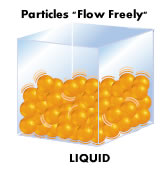(a) Has a definite volume but not a definite shape

- The liquid molecules are closely packed together but not rigidly. Held together by a strong intermolecular forces but not strong enough to hold the molecules firmly in place (or in definite shape). Thus, liquid molecules are able to move freely.
- Liquid flows to fit the shape of its container and confined to a certain volume.
(b) Surface tension
- Molecules within a liquid experienced intermolecular attraction in all directions by their neighbouring molecules.
- Molecules at the surface are pulled downward and sideways by the neighbouring molecules, but not upward away from the surface.

- These intermolecular attractive forces tend to pull the molecules into the liquid and cause the surface to tighten like an elastic film.
- Surface tension is caused by the intermocular attractive forces acting within the liquid molecules. The stronger the intermolecular attractive forces, the higher the surface tension.
(c) Viscosity

- A measure of a resistance of fluid to flow. The greater the viscosity, the slower the liquid flows.
- When a liquid flows, one portion of the liquid moves with respect to neighbouring portions. Cohesive forces (the intermolecular attraction between like molecules) within the liquid create an “internal friction” which reduces the flow rate.
- Factors:
The higher the molar mass (larger size), the greater the van der Waals force, the more resistance their flow.
(ii) The strength of the intermolecular attractive forces between the molecule
The stronger the intermolecular attractive forces, the greater the viscosity.
(d) Compressibility

- In a liquid, the molecules are closely packed together. There is very little empty space.
- Thus, liquids are more difficult to compress than gases.
(e) Diffusion

- Athough the liquid molecules are in rapid motion, they are not able to move freely from one part of a liquid to another. The intermolecular attractive forces bind them into a loose network with neighbouring molecules and restrict their movement.
- Diffusion of liquids happen when a molecule breaks free from the network of molecules that surround it, and moves to another region of the liquid.
- The rates of diffusion of liquids are less than gases because:
(ii) Lower kinetic energy of liquid molecules.
(iii) Stronger intermolecular attractive forces between the liquid molecules compared to gas molecules.
2. Phase change of matter

3. Vaporisation
(a) Vaporisation is a process in which a molecule changes from liquid to vapour phase.
(b) Description of the vaporisation process:
- Liquid molecules are closely packed together but not rigidly.
- When a liquid is heated, the temperature is increased. As the temperature increases, the kinetic energy of liquid molecules increases and thus their molecular motion also increases. Molecules in a liquid move quite freely and collide with one another.
- As the molecular motion become so intense that the molecules at the liquid surface possess enough kinetic energy to overcome the intermolecular attractive forces that bind them together, they escape as vapour.
(c) Factors that influence the rate of vaporisation:
(i) Surface area
The larger the surface area, the higher the chances for the molecules to escape from the surface. Thus, the rate of vaporisation is higher.
(ii) Temperature
At higher temperature (or when temperature increased), the kinetic energy of the molecules increases. More molecules have enough energy to overcome the intermolecular attractive force and escape as vapour from the liquid surface. Thus, the rate of vaporisation is higher.
(iii) Intermolecular attractive forces
Liquid with stronger intermolecular attractive forces (less volatile liquid) requires more energy to overcome the intermolecular attractive forces between molecules. Thus, the rate of vaporisation is lower.
(d) It occurs at any temperature and pressure (as long as the molecules at the liquid surface possess enough kinetic energy to overcome the intermolecular attractive forces that bind them together).
(e) It occurs on the surface of a liquid.
4. Condensation
(a) Condensation is a process in which a molecule changes from vapour to liquid phase.

(b) Description of the condensation process:
- Some of the vapour molecules lose their kinetic energy during the collisions or when the temperature is lowered.
- They do not have enough energy to remain as vapour molecules.
- They reach to the liquid surface and trap by the intermolecular attractive forces.
- If they cannot overcome the intermolecular attractive forces, these vapour molecules return as liquid molecules.
5. Vapour pressure

Vapour pressure is the pressure exerted by a vapour at equilibrium with its liquid in a closed system. It occurs when the vapour molecules are trapped in a closed container and collide with the wall of the container.
6. Boiling
(a) Boiling is a process in which a molecule changes from liquid to vapour phase.

(b) It occurs at a specific temperature and pressure, called boiling point (when the vapour pressure of its liquid is equal to the atmospheric pressure).
(c) It occurs on the surface and inner part of a liquid.
(d) The boiling temperature in which the vapour pressure of its liquid is equal to 1 atm is called normal boiling point.

(b) It occurs at a specific temperature and pressure, called boiling point (when the vapour pressure of its liquid is equal to the atmospheric pressure).
(c) It occurs on the surface and inner part of a liquid.
(d) The boiling temperature in which the vapour pressure of its liquid is equal to 1 atm is called normal boiling point.
No comments:
Post a Comment